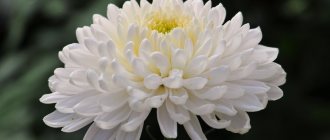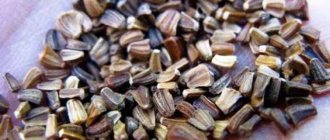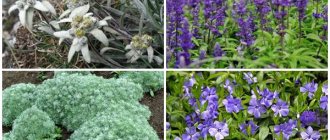Growing chrysanthemums in a garden plot is very popular, and the talent and skill of an amateur gardener lies in creating a unique and inimitable garden in every season of the year. The chrysanthemum rules the autumn garden! It has a riot of colors no less than summer flowers, and in its unpretentiousness this plant has no equal.
Description and characteristics of the flower
Chrysanthemum, like hydrangea, is a perennial ornamental shrub. The root system is represented by a thickened, branched rhizome, which can produce stolons (underground shoots).
The stems of chrysanthemums are erect, depending on the type, their height varies from 25 to 120 cm. The branching of the shoots can be weak, medium or strong (the latter is more common). Leaves can be small, medium or large. It all depends on the type and variety of chrysanthemum.
Numerous leaf blades are attached directly to the stem or supported by petioles. They are elongated in shape, the degree of dissection of the edges varies greatly.
The upper surface of the leaves is green without pubescence, and the reverse surface is usually densely pubescent, making it appear bluish or gray. The whole plant has a specific smell.
The inflorescence of chrysanthemums is called a basket; it includes many, sometimes up to a thousand, reed and tubular flowers. The terry nature of the basket is achieved by turning tubular flowers into reed flowers.
The number of inflorescences on a plant depends on the type and variety of chrysanthemum.
Storing chrysanthemums in winter
Large-flowered varieties of chrysanthemums, dug out of the ground for the winter, are stored in greenhouses or basements at a temperature of 8-10 degrees Celsius. In order for the plant to overwinter better, it is advisable to cover its root system. A layer of sand, peat, humus or a dense layer of leaves will do just fine. It is easier to deal with small-flowered varieties (white and lilac in the photo), for which for the winter, without digging, we must cover the root system with any non-woven material, since severe frosts can damage the roots of the plants, which will subsequently lead to their death.
Chrysanthemums are decorative for up to 6 years, then their inflorescences become smaller. To prevent this from happening, every 4 years we transplant the plant bushes in our dacha to a new location.
Types and varieties of chrysanthemums
In Japan, in the first millennium AD, the chrysanthemum became the national flower. In Europe, mass distribution, study and selection of chrysanthemums began in the 18th and 19th centuries.
Garden chrysanthemum is used in creating compositions and flower bed planting in gardening, and is also cultivated as a cut crop in open ground and greenhouses. When cut, it does not fade for a long time and pleases with pleasant colors and texture of the flower.
Among the chrysanthemums with small flowers, the Korean Chrysanthemum group is distinguished. It is characterized by increased resistance to low air temperatures.
An amateur florist may be interested in the Chinese classification based on the color of the chrysanthemum flower. So, there are seven main colors:
- white, yellow,
- cream, purple,
- red, bronze,
- green.
In addition to monochrome, inflorescences can be two-colored: different sides of the flower are colored differently.
In China, 3 thousand varieties are cultivated, but the most common and described are about a thousand, which according to the classification are classified as nine types of inflorescences. The most common and interesting are chrysanthemums with simple, semi-double, double, spherical, feather-shaped and radiant inflorescences.
In Japan, chrysanthemum is also used as a salad crop. Therefore, the classification of species there includes food and ornamental.
Korean species are classified as small-flowered chrysanthemums. The size of the flowers of this species does not exceed 10 cm, and more often between 2 and 8 cm. The small leaves along the cut edge resemble an oak leaf, which is why the popular name for chrysanthemums appeared - “oaks”.
The earliest chrysanthemums begin to bloom in August and continue until frost sets in.
Variety "Cheburashka"
Popular varieties of chrysanthemums: Cheburashka, Talisman, Multiflora .
Large-flowered varieties are heat-loving, they are cultivated in greenhouses for cutting, these include the following varieties: Orange ball, Valentina Tereshkova .
"Amber Lady"
Common varieties of tall garden chrysanthemums:
The Amber Lady blooms with golden flowers;
Umka is a so-called pompom chrysanthemum with snow-white flowers; Rosetta's daughter is a type of flat chrysanthemum with pinkish flowers.
Medium-sized chrysanthemums have bushes up to 0.5 m high. In this group, the Zorka with “red” flowers are interesting;
"Dune"
Dune , the variety has flowers of iridescent color - from dark yellow to golden.
The Lily variety is characterized by burgundy flowers, it is very popular, a compact bush no more than 30 cm high.
It is advisable to form border chrysanthemums in the form of a ball; usually these include Korean small-flowered species. Varieties have spread among us: Varvara has lilac-lilac flowers;
"Evening Lights"
Evening lights - with inflorescences of deep scarlet color;
The talisman has burgundy-red flowers.
Garden chrysanthemums have five different types of flower shapes:
Pom pom flowers are an assembly of reeds that form a ball that resembles a pom pom.
Anemone-shaped flowers consist of large petals, which are arranged in one, two or three rows. The flowers themselves are small in size and very similar to anemone flowers. Single-row and double-row inflorescences are bordered by flowers that look like tongues. In the center of such inflorescences small tube flowers grow. The border of flowers can be arranged in one or two rows.
Semi-double flowers consist of three rows of reeds that are arranged around a central flower.
Double inflorescences are similar to semi-double ones, but their flowers are more lush because they are varied in appearance and shape.
Varieties of tall chrysanthemums
It is impossible not to pay attention to the tall, bright and abundantly flowering plants in the autumn garden. A variety of colors and shades create a mood even on a cloudy day.
Emily. Chrysanthemum with simple flowers and petals of two shades. Closer to the center they are pink, and at the edges they are white. The size of the basket reaches 9 cm, and the height of the bush is 1 m. The plant is well-leafed and compact.
Belyanka. The double inflorescences of this variety are slightly lowered to the ground, seemingly due to the abundance of pale pink or pure white petals. The diameter of the flower is 6 cm, and the height of the plant can be from 50 to 80 cm.
Dolly. A densely leafy variety, with a bush height of 85 cm and an inflorescence size of 5 cm. The flowers are simple, but have bright colors. The main color of the petals is red-crimson, and yellow at the very tips. Combined with dark green foliage, the plant looks great in any corner of the garden.
"Autumn Waltz"
Autumn Waltz. The petals of this variety contain three colors: white, pink and yellow. Double inflorescences measuring 4 cm in size crown a stem whose height reaches 60 cm. Dense dark green foliage and delicate flowers attract late-arriving insects.
Varieties of medium-sized chrysanthemums
No less attractive are low flower bushes with a huge number of inflorescences of various shades. This group of chrysanthemums has strong stems and this allows it to be grown as a potted crop.
"Olenka"
Olenka. Chrysanthemum of this variety has a delicately colored inflorescence. The yellow-orange petals droop coquettishly when the flower opens fully. The size of the basket is approximately 5 cm. Can be used for bouquets; it lasts in water for about a month.
Splashes of the sea. The yellow tongues of this small-flowered chrysanthemum are marked with orange strokes and stripes. The height of the plant is up to 65 cm, and the diameter of the flower is up to 7 cm.
"Stranger"
Stranger. Amazingly beautiful flowers combining soft pink, cream and white shades. The inflorescence, about 6 cm in diameter, looks as if it has not fully opened. And this gives the “Stranger” chrysanthemum a special charm. The 40 cm tall bush has strong stems and is good for container growing.
Varieties of low-growing chrysanthemums
Miniature bushes of abundantly flowering chrysanthemums create bright mats of various colors in the autumn garden, warming the gardener's soul with beauty.
Purple . A luxurious border variety, not exceeding the 35 cm mark. The bush is densely covered with inflorescences of lilac tones. Because of the flowers, the foliage is practically invisible, and they themselves seem frozen. Chrysanthemums of this variety look great in floral arrays. They are also suitable for making bouquets.
"Mount [email protected]
Mount Carmen. The color of the flowers of this border variety is so bright yellow that even on a cloudy day the garden looks elegant and sunny. The inflorescence is semi-double, about 5 cm in diameter.
Fantasy. Low-growing chrysanthemum with delicate pink inflorescences. Lush double flowers reach 5 cm in diameter. When planted frequently (25 cm), they create bright flower carpets. Can be grown in pots and containers.
Among the huge selection of chrysanthemum varieties, the gardener needs to choose the one he likes and decorate his garden or garden with it.
Indian chrysanthemums
Today there are more than 10,000 varieties of Indian chrysanthemums.
Among them there are specimens with both large and small flowers. Among them there are also relatively winter-hardy chrysanthemums that can be grown even in the Moscow region. Mostly large double flowers are represented. Their parts are used by florists for flower arrangements. Below are some of the most common varieties of Indian chrysanthemums.
Gazelle
The variety blooms early with white buds up to 17 cm in diameter. The length of daylight directly affects the decorative effect. Just 10 hours is enough.
Aurora
One of the most famous varieties of Indian chrysanthemums. It grows up to a meter in height. Bright orange flowers of medium size, up to 10 cm in diameter. It blooms for two months (August - September).
Among Korean chrysanthemums there is also the Aurora variety.
Alec Bedser
Early variety. Blooms in September-October. Grows up to 70 cm. The plant requires careful care in open ground.
The flowers are large, up to 14 cm in diameter, yellow in color. Can be grown both for cutting and for flower beds.
Anastasia
The variety includes many subspecies, each of which has different color shades: white, pink, lilac
. There are also varieties of yellow shades (dark, light, lemon and others).
The size of the inflorescences of all flowers is the same with a diameter of up to 17 cm. The petals are thin. Flowering is long: from the beginning of September until the frosts at the end of November.
Choosing a place for perennial chrysanthemum
When thinking about where to plant a chrysanthemum, you need to expect that the bush will grow in one place for at least 10-12 years. Therefore, it should fit well into the overall design of the garden and match its style.
A tall bush can act as a tapeworm. In this case, you need to choose a sunny place with fertile soil. It is permissible to surround the chrysanthemum bush with a lawn. Low-growing varieties are most often planted in mixed borders in compositions with flower crops that bloom in a different period of time or in borders of the same species.
If the chrysanthemum is planted in a composition, then it is important to choose plants that will not be its antagonists. Good combinations are obtained when planting chrysanthemums together with cineraria, asters, and garden daisies. Asters need to be selected that are in harmony with chrysanthemums according to the texture of the flower.
Currently, potted chrysanthemum culture has become very popular. The advantages of potted culture lie in its mobility; flower pots can be placed at any time in the right place: on the veranda, on the stairs, on the balcony, or even placed in the yard.
You can please your guests by greeting them with flowers. A pot with a low-growing chrysanthemum will not take up much space, does not require complex care, and is always highly decorative. To maintain decorativeness, the bush can be trimmed or subjected to the so-called molding, if possible giving it a rounded shape.
History of the origin of chrysanthemums
The history of chrysanthemums originates in the country of the cult of flowers - China. Even then, powerful emperors admired the stunning flowers. In some periods of time they were compared to gold and profitable exchanges were made. The legendary chrysanthemums won universal love several thousand years ago. And although they have changed significantly since the days of imperial honors, offering today their extraordinary variety, their popularity has never changed.
The progenitor of all varieties is the Indian chrysanthemum and mulberry chrysanthemum. The first cultivated species had small, only yellow flowers. The plant first appeared in Europe in the 17th century; Russian gardeners were lucky enough to acquire specimens only towards the end of the 19th century.
Chrysanthemum is the real queen of autumn; it delights our eyes with its bright colors right up to the snow.
There are many legends telling about the appearance of the flower. One of the most revered ones says that an evil dragon wanted to steal the sun, but the luminary burned his paws. Enraged, he tore it into pieces. The sparks that fell to the ground turned into chrysanthemums. The name of the plant is translated from Greek as golden-flowered.
Chrysanthemum was cultivated in garden conditions in the 5th-6th century BC. The first written mention comes from Confucius. The most accurate description of ancient flowers was made in 1753 by the father of modern taxonomy, Carl Linnaeus. Surprisingly, this plant has never been found in the wild, until now.
Autumn and spring planting
The time for planting chrysanthemum bushes will depend on what planting material is used. If you used sowing seeds for seedlings, then the seedlings are planted in the spring. The best time is April, May.
Young bushes are not afraid of light frosts in the atmosphere, but if frosts are expected on the soil, then it is better to wait until the end of May - beginning of June with planting. If planting is carried out with cuttings taken from a bush in the summer, then the best time will be September. Young bushes should get stronger in a permanent place before the onset of persistent frosts.
If you plan to plant bushes from layering or formed by dividing a bush, then it can be done a little later - in October, since such bushes are quite frost-resistant and are not afraid of light frosts.
When planting in spring, fertilizers containing nitrogen are added to the hole, and when planting in autumn, nitrogen fertilizers are excluded. Young plants can be covered for the winter with textile covering material. In the spring after planting, the plants are watered and covered with mulch made from sawdust, pine needles, and compost. Mulch will protect the roots from drying out and will encourage less frequent watering.
Caring for chrysanthemums in the open ground
It is believed that the chrysanthemum is not a capricious flower and does not require the gardener to spend a lot of time and effort on growing and caring for it. To some extent, this is true, but some conditions still need to be met in order to get a chrysanthemum with lush flowering.
Watering has a significant impact on the time at which chrysanthemums begin to bloom and on their overall character.
Chrysanthemums grow well in pots
plant development. Small-flowered forms, with small and densely pubescent leaves, need to be watered less frequently than large-flowered varieties with delicate leaves. The soil should not dry out, nor should there be strong fluctuations in humidity.
This can lead to a lack of flowering or even death of the plant. Excessive watering is also dangerous for chrysanthemums. Excess moisture causes the rhizomes to rot and the plant to be affected by powdery mildew. When choosing a watering method, you can use sprinkling with complete confidence.
Chrysanthemums love to bathe in the rain, a lot of dust accumulates in the small leaves, and after watering the bushes look fresh and healthy. The now popular drip irrigation is completely unsuitable for them. You can opt for traditional hose irrigation. It’s very nice to stand with a hose at dawn and admire the blooming mixborder.
Feeding is also important for the growth of chrysanthemums. When planting in spring, the first fertilizing can be done after the bushes have rooted, approximately 2-3 weeks after planting. For fertilizer use azofoska, kemira or any spring fertilizer.
Chrysanthemums are very responsive to foliar feeding with modern amino acid-based fertilizers, for example, Isabion. When the bushes form buds, they are fed with organic matter or humic fertilizer. In late autumn, rotted manure or humus is added.
Forming a bush and pinching garden chrysanthemums
To give the chrysanthemum bush a more attractive appearance, pruning is used. It is advisable to form medium-sized varieties into rounded ones. To do this, pinch the central shoot at the desired height, usually 16-20 cm, thereby encouraging it to branch.
When the shoots of the first order reach the same length, they are also pinched and the growth of shoots of the second order is expected.
If large-flowered varieties form several flowers on a shoot, it is advisable to leave only one flower on the shoot and remove the side ones. In this case, the left flower will develop larger.
Chrysanthemum propagation
Of course, seeing these magnificent flowers, many summer residents will have a desire to grow them on their plot. To do this, you need to know how chrysanthemums reproduce. And there are quite a few ways of reproduction.
by seeds ; they are very similar to daisies or asters. Sowing
Chrysanthemum seedlings
held in early or mid-May. By this time, the soil will become comfortable for germination - this is 13-17˚C. The seeds are distributed along moistened grooves, the distance between which must be maintained at 15-20 cm. The first shoots should appear in a week or 10 days. To speed up germination, crops can be covered with polyethylene.
In addition, this will protect the soil from excessive evaporation of moisture, or vice versa: rains will not drive the seeds deep into the ground. After the seedlings grow, become stronger and become cramped in the nursery, care should be taken to provide them with a larger feeding area.
Some people thin out the seedlings, replanting the extra ones in a separate bed, while others place the chrysanthemums in a designated place, observing the above distance between plants.
The second option for sowing in open ground : holes are made in the soil at a distance of 50 cm from each other for large-flowered chrysanthemums and 20-25 for small-flowered ones. 3-4 seeds are placed in them and sprinkled with soil. In this case, subsequent plant replanting will not be necessary.
In addition, the seeds can be sown at home in March-April.
Almost all types of chrysanthemums can be propagated by cuttings They take root well in a light soil mixture with peat and sand. Cuttings measuring 6-7 cm are preliminarily kept in a solution of the drug “Kornevin” and planted in a box, deepened by about 2 cm, then they are sprayed with a spray bottle and covered with glass.
This can be done in August, when it is no longer too hot and cuttings can be cut in unlimited quantities. After 3-4 weeks, the cuttings take root and can be planted in the ground or in pots.
You can propagate your favorite chrysanthemum variety by layering To do this in the spring, you need to pin one or several outer branches of the bush to the ground at its top. Over the summer they will take root and send out one or more shoots. In the fall, it will be possible to separate the young plants from the mother plant.
Bush division is used when you need to plant an adult chrysanthemum bush. In this case, they dig it up and divide the rhizome into several parts, so that each of them has at least two shoots and many buds on the rhizome. In this form they will take root faster and will bloom next season.
The procedure for dividing the queen cell must be carried out every 2 or 3 years. This is not only a way to obtain new plants, but also mandatory rejuvenation work. Thickened chrysanthemum bushes lose their aesthetic appearance. The inflorescences become smaller and, if measures are not taken, the plant stops blooming.
Wintering chrysanthemums
Chrysanthemums suffer from early autumn frosts. If you cover the chrysanthemum bushes during frosts, they will delight you with flowers for a long time.
In autumn, large-flowered and small-flowered cut varieties are dug up, planted in flower pots or boxes and brought into a bright room (insulated veranda). Water generously, as the numerous leaves use a lot of moisture.
Preparing chrysanthemums for winter.
Preparatory work for wintering chrysanthemums
- For faded chrysanthemums, the stems are cut to 15 cm from the ground.
- Carefully dig up the bushes, shaking off some of the soil.
- Remove all the leaves, tie a label to each stem and plant in boxes covered with compost.
- Store in a well-ventilated dry room at a temperature of 4-7 degrees, or in a greenhouse.
Pest and disease control
Chrysanthemums are slightly susceptible to diseases.
In general, plants are resistant to diseases and pest attacks. High resistance can be explained by the characteristic smell of plants, which repel pests, and the hard tissue shells are difficult for penetration of fungi - sources of various kinds of diseases.
Leaf spotting (septoria) of garden chrysanthemum. The cause of septoria can be excessive humidity or dense planting of chrysanthemums. As a result, the ventilation of the plants is disrupted and changes in the form of dark brown spots begin to appear on the leaves. The lower leaves are the first to suffer, over time they turn yellow and fall off, and the fungus moves to healthy greenery.
To get rid of septoria, use:
- Bordeaux mixture. Spraying is carried out with a 1% solution.
- copper-soap solution. 10 liters of water + 20 g of copper sulfate + 200 g of green soap.
If a white coating is noticed on the leaves, this indicates that the plant is infected with powdery mildew . To combat this disease, the same drugs are used as for leaf spot: Bordeaux mixture and a water-soap solution.
Large-flowered chrysanthemums are sometimes attacked by spider mites. You can notice this pest by the presence of a thin web enveloping the buds. In this case, spraying with acaricides will help.
When plants are damaged by nematodes, which is expressed in browning of the lower leaves, and then of the higher ones, it is necessary to use insecticides. Infection can occur through soil, irrigation water or contaminated planting material. Therefore, the land where the diseased plants grew must be treated with a formaldehyde solution, and the infected chrysanthemum bushes must be burned.
Before planting, flower seedlings must be treated with a Phosfamide solution; 10 g of the drug is diluted in 10 liters of water. Chrysanthemums are sprayed with the same solution after they are dug out of the ground in the fall.
Preparing chrysanthemums for winter
Most varieties of chrysanthemums are winter-hardy and do not require additional shelter. In addition, they bloom for a very long time and often disappear under the snow with flowers. Therefore, it is advisable to prune above-ground shoots in the spring. And in the fall, mulch the root system with rotted manure or compost. This will be both shelter and additional organic fertilizer for the bush.
Do not leave large-flowered chrysanthemums on the site, which will not be able to survive during the winter cold. The plants are pruned, dug up, if necessary, treated with drugs against diseases, transplanted into some container and stored in the cellar. The content temperature should be within 3-5˚C.
Chrysanthemums under the snow
An important factor is keeping the root system moist, so during storage it is necessary to ensure that the soil in the container is dry and, if necessary, add a few handfuls of snow or spray the surface of the soil with a spray bottle.
Many gardeners are faced with the fact that their chrysanthemum bushes bloom very late, when it is already cold and they are not in their garden plot. Late-opening flowers are hit by frost and, in fact, the summer resident does not get any pleasure from such bushes. The problem is that the variety was chosen incorrectly; apparently it belongs to the southern type, and it needs to be replaced with a zoned plant.
In general, chrysanthemums are unpretentious and, with careful attention to them, can delight with beauty and create a unique charm in the autumn garden. It is no coincidence that the perennial garden chrysanthemum is called the queen of the autumn garden.
Large-flowered chrysanthemum species
Large flowers of various colors on strong long stems are ideal for making compositions and bouquets. They belong to the Astrov family, have a thickened root system, and highly branched shoots. The leaf blade is large - 20 cm long, 10 cm wide. The shape of the edges is wavy without jagged edges.
Click on the photo to enlarge.
Click on the photo to enlarge.
Large flowers can remain single or form multiple inflorescences with a basket diameter of up to 30 cm. Flowers can be anemone-shaped, spherical, hemispherical, with simple, ray-shaped, spider-shaped, curly-bent inflorescences. The variety produces little seed material, so propagation by division is preferable bush.
The main advantage of large-flowered chrysanthemums is their excellent external appearance. A huge selection of shades allows you to create beautiful compositions from different species, combining them with other small, tall shrubs. Most varieties bloom for more than 3 months and are frost-resistant. Flowers do not tolerate excessively wet soil, lack of heat and sun, and are susceptible to fungal diseases.











